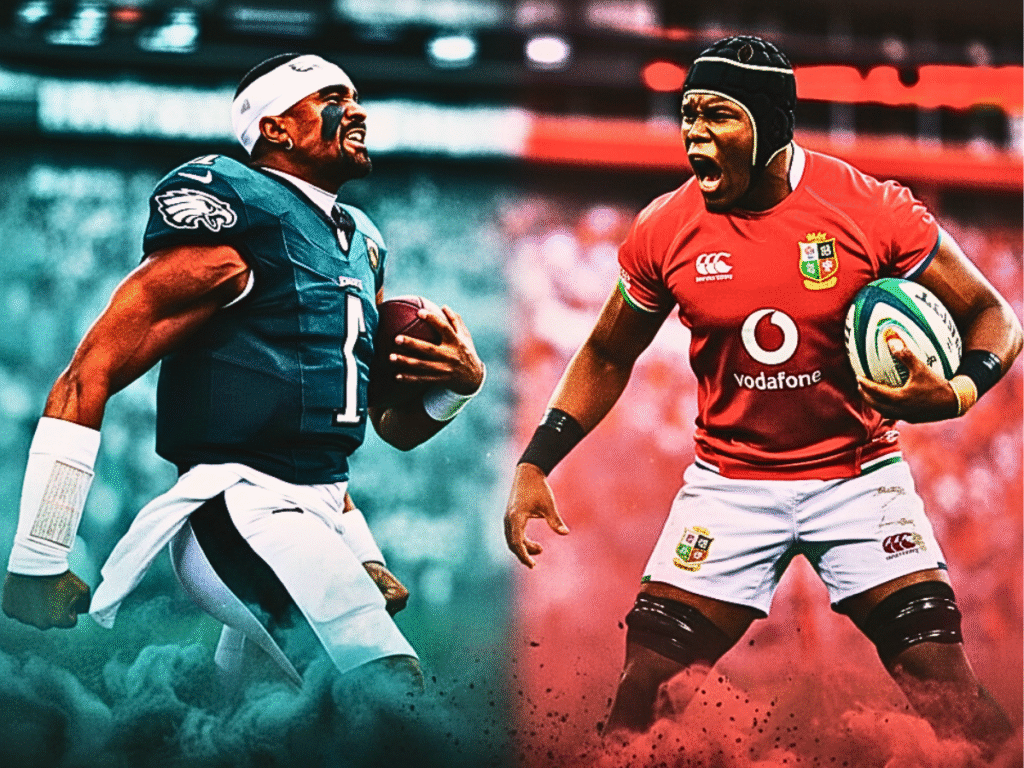
American football vs rugby might look similar at first glance, but they are very different games. Many fans wonder, what is the difference between American football and rugby? The answer lies in the flow of the game and the rules of contact.
Rugby vs American football is a classic debate about toughness. The difference between rugby and American football starts with their origins.
So, which came first, rugby or American football? Rugby came first, with American football evolving from it later. This history created the rugby and American football that we see today.
When watching rugby vs football, you will notice the pace immediately. American football is a game of planned plays with frequent stops.
Rugby is a continuous, flowing sport with almost non-stop action. This is a key difference between the National Football League (NFL) and rugby league play.
People often ask if American football and rugby are similar in how they handle the ball. They are not. In rugby, you cannot throw the ball forward. Every pass must go backward.
So, what is the difference between rugby and American football in simple terms? Think of one as a series of powerful sprints and the other as a long, grueling cross-country run.
Both are incredibly tough, but in their own ways. Understanding rugby and football helps you appreciate the unique strength and strategy each sport demands.
Neither sport is definitively tougher, as each demands a different type of athleticism. The choice depends on how you define “tough.”
Rugby requires superior stamina and endurance.
Continuous Play: Players compete in 40-minute halves with minimal stoppages.
Minimal Protection: The sport is played with little to no padding, emphasizing technique.
Total Fitness: Every player must attack, defend, and cover a massive field.
American football focuses on explosive power and high-impact collisions.
Extreme Force: Players wear extensive protective gear due to the violent nature of collisions.
Strategic Sprints: The game is a series of short, maximum-effort bursts.
Specialized Roles: Athletes train for specific, high-velocity tasks.
Verdict: Rugby is a grueling marathon of endurance. American football is a series of violent sprints. Both are incredibly tough, just in different ways.
Table of Contents
Key Takeaways
- Both games have some similarities. American football is a mixture of Rugby and soccer. However, different sets of rules separate them.
- Understanding the differences between roots and associations is crucial. For instance, American football is typical of the United States, while Rugby has international appeal.
- Differences in field size, scoring methods, equipment, uniform, and cool tackling methods between American Football vs. Rugby.
- Player safety is a significant concern in American football and Rugby, and it has evolved over the years.
- The popularity of a game and the direction of fans define further trends and developments in these sports.
- Finally, discuss some noteworthy NFL players and Rugby Union players.
1. Rugby vs. American Football Origins
American football and rugby share the same family tree, but these sports took different paths over time. Many people wonder which came first, rugby or American football. Rugby actually started earlier at Rugby School in England around 1823.
A student named William Webb Ellis is credited with creating the game when he picked up the ball during a soccer match and ran with it. The sport grew across England and then spread worldwide.
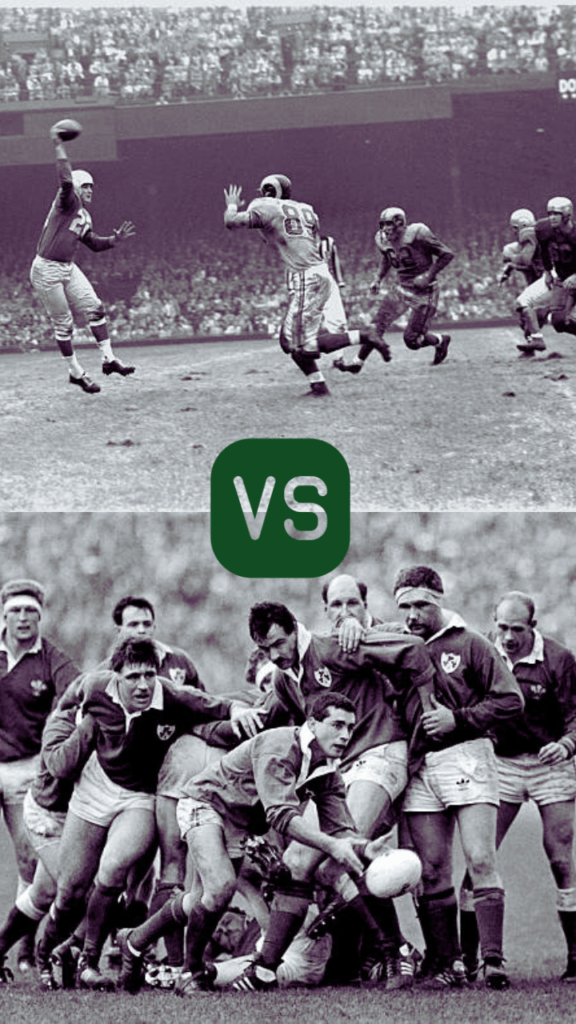
American football began in 1869 when Rutgers and Princeton universities faced each other in the first college game.
Walter Camp, known as the father of American football, changed the rules in the 1880s. He introduced the line of scrimmage, the down system, and point scoring. These changes made the game uniquely American.
The difference between rugby and American football became clear as each sport developed its own identity. Rugby kept its continuous play style, while American football added strategic stops and specialized positions.
Both games require strength and teamwork, yet they feel completely different when you watch them. Understanding their origins helps fans appreciate what makes each sport special today.
Rugby came first. The rules of rugby were first codified in 1871 with the formation of the Rugby Football Union (RFU) in England . American football began to evolve from rugby in the late 19th century, with the first intercollegiate game played in 1869 and Walter Camp’s rule changes in the 1880s, such as introducing the line of scrimmage and the down-and-distance system—establishing it as a distinct sport
2. Governing Body
USA Football stands as the official organization protecting American football across the nation. This group joined the International Federation of American Football in 1998 and works to keep players safe while teaching proper techniques.
They created youth programs that focus on tackling methods that protect young athletes from injuries.
Rugby follows its own journey through USA Rugby, which became part of World Rugby back in 1987. World Rugby started in 1886, making it one of the oldest sports organizations. The difference between rugby and American football shows clearly in how these governing bodies operate.
USA Football writes rules for equipment standards and coaches thousands of volunteers each year. They established their mission to reduce concussions and make the game safer for children.
Rugby and American football difference becomes obvious when you watch how USA Rugby handles player safety without helmets or pads. They teach players to tackle lower and use proper form as their main protection.
Both organizations love their sports deeply and work hard every day to help athletes play the games they cherish.
3. Rugby vs. American Football Fundamental Rules and Gameplay
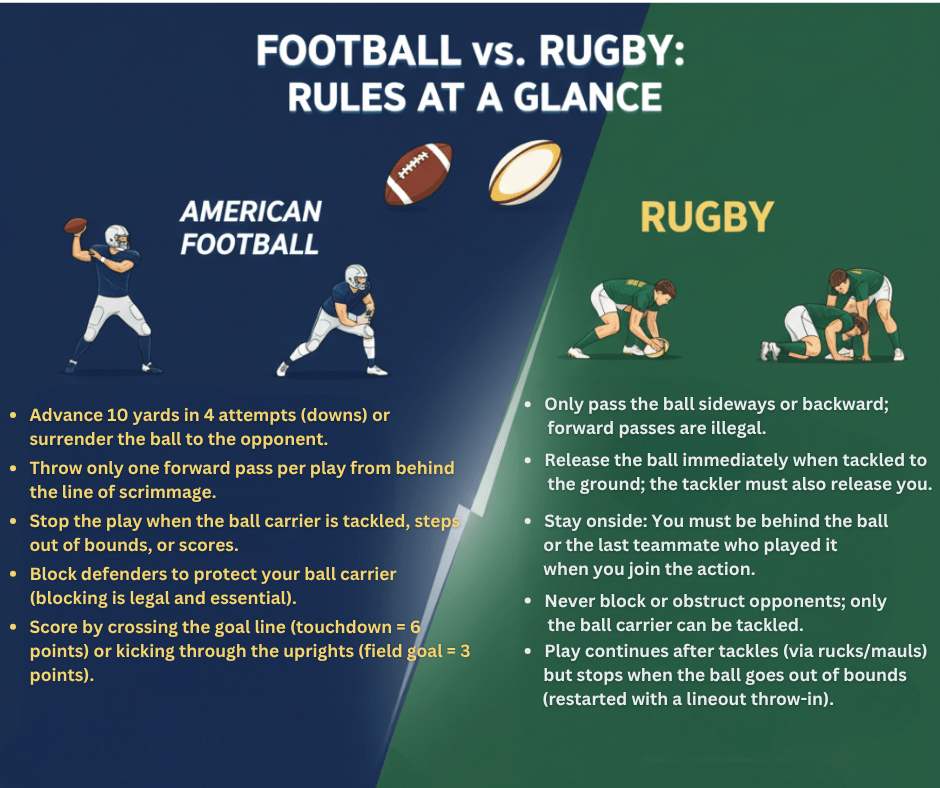
Official Rules Comparison: American Football vs Rugby Union
Core Rules Overview
| Rule Category | American Football (NFL Rules) | Rugby Union (World Rugby Laws) |
|---|---|---|
| Field Dimensions | 360 feet (120 yards) long × 160 feet (53⅓ yards) wide; includes two 10-yard end zones. | 328 feet (100 meters) long × 230 feet (70 meters) wide; includes two in-goal areas up to 72 feet (22 meters) deep. |
| Number of Players | 11 players per team on the field | 15 players per team on the field |
| Game Duration | 60 minutes divided into four 15-minute quarters | 80 minutes divided into two 40-minute halves |
| Objective | The offense advances the ball to score by crossing the opponent’s goal line or kicking through the uprights | Teams advance the ball to score by grounding it in the opponent’s in-goal area or kicking through the uprights |
Possession and Advancement Rules
| Rule Category | American Football (NFL Rules) | Rugby Union (World Rugby Laws) |
|---|---|---|
| Advancing the Ball | The offense must advance the ball at least 10 yards within four consecutive downs to retain possession. If the offense fails to gain 10 yards after four attempts, possession transfers to the opponent at the spot where the ball becomes dead. | Teams may advance the ball by running with it, passing it backward or laterally, or kicking it forward. No system of “downs” exists; play continues until a stoppage occurs. |
| Forward Pass | The offense may throw one legal forward pass per down from behind the line of scrimmage. The passer must be behind the line when releasing the ball. Only eligible receivers (players numbered 0-49 and 80-89, or linemen who report as eligible) may catch a forward pass. | Forward passing is illegal. Players may only pass the ball sideways or backward. A pass is considered forward if the ball travels toward the opponent’s goal line from the passer’s hands. |
| Ball Possession | A player gains possession when he is inbounds, has complete control of the ball with his hands or arms, has both feet or another body part on the ground inbounds, and performs an act common to the game. | A player gains possession when the player is holding the ball or carrying it in any direction. The ball must not be passed forward. |
| Change of Possession | Possession changes when: (1) the defensive team intercepts a forward pass, (2) the defensive team recovers a fumble or backward pass, (3) the offense fails to gain 10 yards in four downs, (4) the offense misses a field goal attempt, or (5) the defensive team catches or recovers a kick. | Possession changes when: (1) a player knocks the ball forward and it is recovered by the opponent, (2) a team fails to release the ball after a tackle, (3) a team commits an infringement resulting in a scrum or turnover, or (4) the opponent catches or recovers a kick. |
Tackling and Contact Rules
| Rule Category | American Football (NFL Rules) | Rugby Union (World Rugby Laws) |
|---|---|---|
| Tackling | Tackling is an attempt by a defensive player to hold a runner to halt his advance or bring him to the ground. The ball carrier is down when: (1) any part of his body other than his hands or feet touches the ground while he is in an opponent’s grasp, (2) he is tackled to the ground, or (3) he goes out of bounds. | A tackle occurs when the ball carrier is held by one or more opponents and is brought to ground. The tackler must immediately release the tackled player. The tackled player must immediately release or pass the ball. |
| Blocking | Blocking is the act of obstructing or impeding an opponent by contacting him with a part of the blocker’s body. Offensive players may block defensive players to protect the ball carrier or quarterback. Blocking is legal throughout the play. | Blocking and obstruction are illegal. Only the ball carrier may be tackled. Players must not obstruct opponents who do not have the ball. This includes preventing opponents from tackling the ball carrier. |
| Ball Release After Tackle | The play ends immediately when the ball carrier is down by contact. The ball carrier retains possession, and the ball is spotted where forward progress stopped. No requirement exists to release the ball after being tackled. | The tackled player must immediately pass or release the ball after being brought to ground. The tackler must immediately release the tackled player and move away or get up. Players may compete for the ball on the ground (forming a ruck). |
Offside and Positioning Rules
| Rule Category | American Football (NFL Rules) | Rugby Union (World Rugby Laws) |
|---|---|---|
| Offside Definition | A player is offside when any part of his body is in the neutral zone or beyond the kicking team’s restraining line when the ball is snapped or kicked. Offensive players must be behind the line of scrimmage (neutral zone) at the snap. Defensive players must not enter the neutral zone before the snap. | A player is offside if the player is in front of a teammate who is carrying the ball or in front of a teammate who last played the ball. Offside players must not participate in play until they return to an onside position. |
| Line Formation | At the snap, the offense must have at least seven players on the line of scrimmage. The two players on the ends of the line are eligible receivers. The five interior linemen and other players behind the line (except those numbered 0-49 and 80-89) are ineligible receivers unless they report as eligible. | No requirement exists for players to form a line. Players may position themselves anywhere on their side of the ball, provided they remain onside. In a scrum, each team must have eight players bound together in three rows. |
| Movement Before Snap/Play | Before the snap, only one offensive player may be in motion, and he must be moving parallel to or away from the line of scrimmage. All other offensive players must be set for at least one second before the snap. Defensive players may move freely before the snap. | Players may move freely before the ball is put into play, provided they remain onside. At a scrum, players must remain bound and stable until the ball leaves the scrum. At a lineout, players must remain in their positions until the ball is thrown. |
Scoring Rules
| Rule Category | American Football (NFL Rules) | Rugby Union (World Rugby Laws) |
|---|---|---|
| Touchdown/Try | A touchdown scores six points. It occurs when any part of the ball is on, above, or behind the opponent’s goal line while legally in the possession of an inbounds player. After a touchdown, the scoring team attempts a Try (extra point) worth one or two points. | A try scores five points. It occurs when a player grounds the ball (places downward pressure with hand or arm) in the opponent’s in-goal area. After a try, the scoring team attempts a conversion kick worth two points. |
| Field Goal/Penalty Goal | A field goal scores three points. It occurs when the ball is kicked from scrimmage or following a fair catch through the plane of the opponent’s goal (between the uprights and above the crossbar). The kick must be a drop kick or place kick. | A penalty goal scores three points. It occurs when a team kicks the ball through the opponent’s goal following a penalty. A drop goal (kicked from open play during regular play) scores three points. |
| Safety/Safety (rare) | A safety scores two points for the defensive team. It occurs when the offensive team is responsible for the ball becoming dead on or behind its own goal line. After a safety, the scoring team receives a free kick from the 20-yard line. | A safety awards two points to the attacking team if the defending team commits an infringement in their own in-goal area or grounds the ball there after carrying it in from the field of play. This is rare in modern rugby. |
Play Stoppage Rules
| Rule Category | American Football (NFL Rules) | Rugby Union (World Rugby Laws) |
|---|---|---|
| Play Dead | The ball becomes dead when: (1) the ball carrier is down by contact, (2) the ball goes out of bounds, (3) a forward pass is incomplete, (4) a score is made, (5) the ball touches the ground during a kick, or (6) an official blows the whistle. | Play stops when: (1) the ball goes out of bounds, (2) a score is made, (3) an infringement occurs, (4) the ball becomes unplayable, or (5) the referee blows the whistle for any reason (injury, foul play, or other stoppages). |
| Out of Bounds | When the ball or ball carrier goes out of bounds, the game clock stops (in certain situations) and the ball is placed at the spot where it went out. Play resumes with a snap from the inbounds line (hash marks). | When the ball goes out of bounds, play stops. The ball is returned to play with a lineout—a structured restart where players from both teams line up perpendicular to the touchline and the ball is thrown in between them. |
| Restart After Stoppage | Play resumes with a snap from scrimmage. The offense must put the ball into play within 40 seconds (or 25 seconds after certain stoppages). The offense may take up to three timeouts per half to stop the clock. | Play resumes with a scrum, lineout, free kick, or penalty kick depending on the reason for the stoppage. The team that did not cause the stoppage typically receives the ball. No timeouts exist except for injury or official stoppages. |
Penalty and Foul Rules
| Rule Category | American Football (NFL Rules) | Rugby Union (World Rugby Laws) |
|---|---|---|
| Penalty Enforcement | Penalties result in loss of yardage (5, 10, or 15 yards), loss of down, automatic first down, or disqualification. The non-offending team may accept or decline the penalty. Common fouls include offside, holding, pass interference, personal fouls, and unsportsmanlike conduct. | Penalties result in: (1) a penalty kick (3 points possible), (2) a free kick (no direct scoring), or (3) a scrum with the ball to the non-offending team. Common infringements include offside, not releasing the ball, collapsing the scrum, and high tackles. |
| Personal Fouls | Personal fouls include unnecessary roughness, hitting a defenseless player, leading with the helmet, face mask grabbing, and late hits. These fouls result in 15-yard penalties and possible ejection. Player safety rules prohibit hits to the head and neck area. | Foul play includes dangerous tackles (high tackles, tip tackles), stamping, punching, and deliberate infringements. Penalties range from penalty kicks to yellow cards (10-minute sin bin) or red cards (ejection from the game). |
Key Differences Summary
| Aspect | American Football | Rugby Union |
|---|---|---|
| Play Structure | Play consists of discrete downs with stoppages between each play | Continuous play with minimal stoppages until a violation or score occurs |
| Ball Movement | One forward pass allowed per play from behind the line of scrimmage | No forward passing; only backward or lateral passes permitted |
| Protective Equipment | Mandatory helmets, shoulder pads, and other protective gear required | Minimal protective equipment; mouthguards and soft headgear optional |
| Substitutions | Unlimited substitutions between plays; teams may substitute any number of players | Limited substitutions; typically 8 substitutes available per match |
| Time Management | Game clock stops for various reasons; teams receive timeouts to manage time | Game clock runs continuously except for injuries and official stoppages; no team timeouts |
4. American Football vs Rugby Field Dimensions and Pitch Layouts
American Football Field Dimensions
Overall Field Size
- The playing field measures 120 yards (109.7 meters) in total length.
- The field width is 53.3 yards (48.8 meters).
- The actual playing area is 100 yards (91.4 meters) long, with two end zones that add 10 yards (9.1 meters) each.
Field Markings
- Yard Lines: White lines cross the field every 5 yards. Numbers appear every 10 yards to show the distance from each goal line.
- Hash Marks: Small lines run down the field at two locations. They sit 70 feet 9 inches (21.6 meters) apart from each other.
- Goal Lines: These lines mark where the end zones begin at each end of the field.
- End Zones: Each end zone extends 10 yards (9.1 meters) deep behind the goal line.
Goal Posts
- The goal posts stand at the back of each end zone.
- The crossbar sits 10 feet (3.05 meters) above the ground.
- The two vertical posts (uprights) are 18 feet 6 inches (5.64 meters) apart.
- The uprights extend at least 35 feet (10.7 meters) above the crossbar.
Rugby Field Dimensions
Overall Field Size
- The playing area measures 100 meters (109.4 yards) in length.
- The field width ranges from 68 to 70 meters (74.4 to 76.6 yards).
- Each in-goal area (similar to end zones) extends 10 to 22 meters (10.9 to 24.1 yards) behind the goal line.
- The total field length, including both in-goal areas, can reach up to 144 meters (157.5 yards).
Field Markings
- The Halfway Line: This line divides the field into two equal halves at the 50-meter mark.
- The 22-Meter Lines: These lines sit 22 meters (24.1 yards) from each goal line.
- The 10-Meter Lines: These lines are 10 meters (10.9 yards) from the halfway line on each side.
- The 5-Meter Lines: Dashed lines run 5 meters (5.5 yards) from each touchline (sideline).
- Goal Lines: These lines mark where the in-goal areas begin.
Goal Posts
- The goal posts stand on the goal line (not behind it like in American football).
- The crossbar sits 3 meters (9.8 feet) above the ground.
- The two vertical posts are 5.6 meters (18.4 feet) apart.
- The posts extend at least 3.4 meters (11.2 feet) above the crossbar.
Yes, a rugby pitch is larger. An American football field is 100 yards long and 53.3 yards wide. A rugby pitch is 100 meters long and up to 70 meters wide, not including its larger in-goal areas. This makes a rugby field both longer and significantly wider for continuous play.
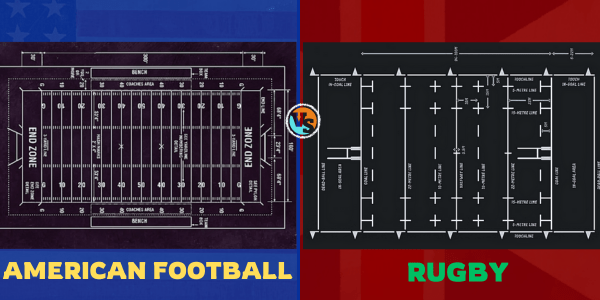
Key Differences Between the Two Fields
Length Comparison
- An American football field’s playing area is 100 yards (91.4 meters) long.
- A rugby field’s playing area is 100 meters (109.4 yards) long.
- Rugby fields are approximately 18 meters (19.7 yards) longer than American football fields.
Width Comparison
- American football fields are 53.3 yards (48.8 meters) wide.
- Rugby fields are 68 to 70 meters (74.4 to 76.6 yards) wide.
- Rugby fields are significantly wider, providing more space for players to spread out.
End Zone Differences
- American football has fixed end zones of 10 yards (9.1 meters) each.
- Rugby has flexible in-goal areas that range from 10 to 22 meters (10.9 to 24.1 yards).
- American football goal posts sit at the back of the end zone.
- Rugby goal posts stand directly on the goal line.
Surface Markings
- American football fields use yard lines with numbers every 10 yards.
- Rugby fields use meter lines with specific marked zones (22-meter line, 10-meter line).
- American football has hash marks for ball placement.
- Rugby has dashed 5-meter lines along the sides for line-out positioning.
Both American football and rugby fields serve their respective sports well. American football fields are smaller and more precisely marked with yard lines.
Rugby fields are larger and wider, allowing for more open play. The goal post positions differ significantly, which affects how each game is played.
Understanding these differences helps fans appreciate the unique characteristics of each sport. Both fields require careful maintenance and precise measurements to ensure fair play and player safety.
Soccer involves kicking a round ball into goals with no hand contact allowed. American football features an oval ball with frequent stops, allowing throwing, catching, and tackling. Rugby uses an oval ball in continuous play where players run, pass backwards, and tackle without protective gear. Each sport has distinct rules governing ball handling and physical contact.
5. American Football vs Rugby Popularity
American football reigns supreme in the United States. The blue line towers over rugby’s modest red curve throughout every season. Something magical happens each fall when pigskin fever takes hold.
Fans pack stadiums wearing team colors like battle armor. Tailgating becomes a ritual that binds communities together. Families gather around televisions for Sunday showdowns and Monday night drama.
The sport evolved from rugby’s roots into something uniquely American. Forward passes changed everything in the early 1900s. Strategic timeouts and specialized positions added chess-like complexity. College rivalries created lifelong loyalties spanning generations.
Rugby never gained that same foothold on American soil. The continuous action confused audiences expecting structured plays. No timeouts meant less drama and fewer commercial breaks. Television networks couldn’t monetize it effectively.
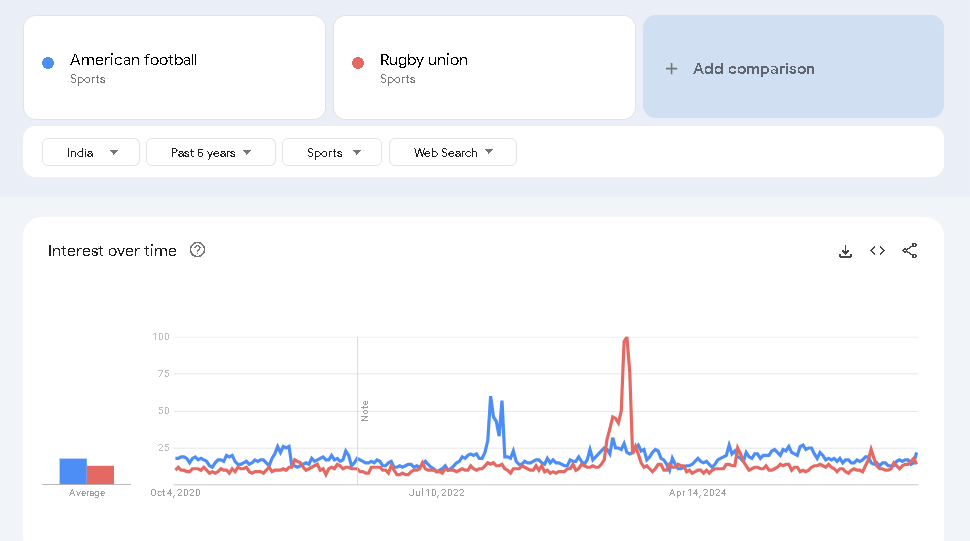
Search interest spikes during football season like clockwork. September through February shows massive blue peaks reaching toward 100. Rugby barely registers except during World Cup years. Those brief red bumps pale against football’s consistent dominance.
Super Bowl Sunday has become an unofficial national holiday. Over 100 million Americans tune in annually. Halftime shows rival the game itself for cultural impact.
The sport speaks to American values somehow. Hard work meets strategic thinking on every down. Individual brilliance shines within team frameworks. Victory requires both brute strength and mental toughness.
That’s why American football wins hearts worldwide.
American football is more popular than rugby in the United States, where it reigns supreme, but rugby has a wider global following. American football’s popularity peaks domestically with events like the Super Bowl, while rugby’s fanbase is more internationally spread .
6. American Football vs. Rugby Equipments & Jersey
It is relevant to compare American football equipment and jerseys with Rugby to correlate the differences between the two games. The following points show the differences:
American Football Protective Equipment
Protective Gear:
Helmet: Required for all players, it is designed to protect the head during extreme collisions.
Shoulder Pads: To protect upper body parts, all players need to wear shoulder pads.
Elbow and Knee Pads: Worn to cushion the joint to minimize impact on the joint.
Gloves: Players use gloves to improve their grip on the ball.
Hip and Thigh Pads: Extra cushioning to shield one in case of a tackle.
Cleats: Shoes specially designed for traction in the field.
Ball: The ball is shaped like a bean, which makes it not spherical, and the player has the privilege of having laces for holding during throwing.
Standard dimensions: It is approximately 6.6-6.8 inches long and about 11-11.25 length in inches.
Jersey: It is made of breathable and absorbent fabrics. Team colors, player numbers, and often the name appear on the back. It is designed to accommodate shoulder pads and other safety features.
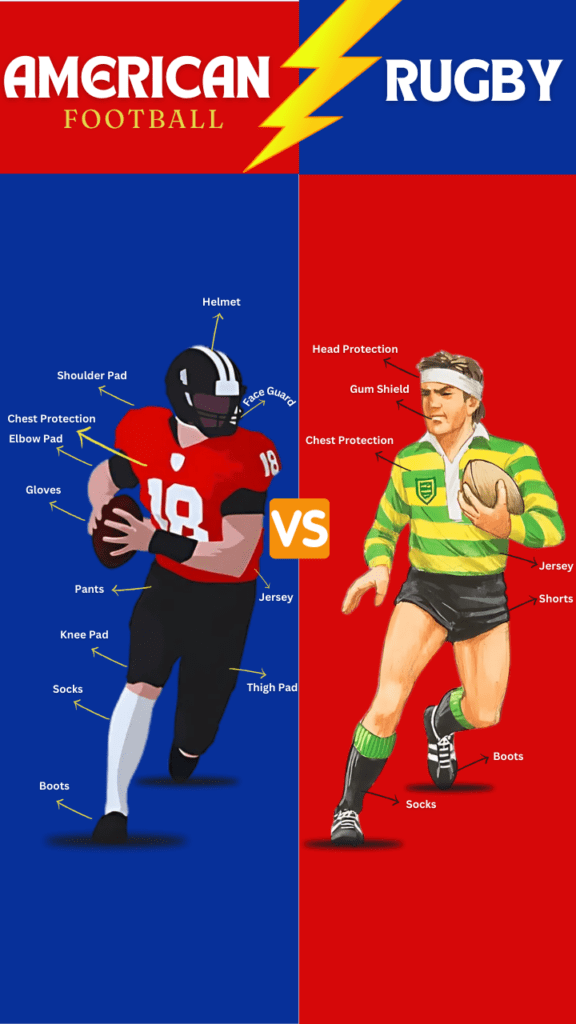
Rugby Protective Equipment
Protective Gear:
Scrum Cap: More like a soft cap that can be worn during scrum and tackles, though it is not compulsory.
Shoulder Pads: It has less padding than American football. Some players may opt to wear little padding.
Body Protection: Light padding is allowed during the compression shirt, for example, forwards.
Cleats: Very similar to American football, but worn usually with fewer studs for more flexibility.
Rugby Ball:
Compared to an American football, the ball is much fatter and is shaped more like a sphere.
Standard dimensions: It is approximately 11-11 inches long and 22.8-24 inches long.
Jersey:
This material is highly stretchable and ideal for children participating in physical activities.
It commonly displays the number and color, but the name is not defined.
Key Differences: American Football & Rugby
Protection Level: Players taking part in American football wear massive protective gear because of the solid contact involved in the game, while Rugby players do not wear much protective gear to enhance stamina and flexibility.
Jersey Design: The outfit worn during the game for the American football jerseys has provision for padding and protective gear, while for Rugby, the jerseys are very flexible, and some do not even come with padding.
Ball Characteristics: In the structure, American football has laces for throwing and catching, while Rugby football, or simply, Rugby has a more rounded shape for handling and kicking.
Gameplay Impact: The differences in equipment reflect the style of each game. American football has well-organized plays and set pieces, while Rugby emphasizes continuous play and fluidity.
Yes, a rugby ball is typically heavier than an American football. A regulation rugby ball weighs between 410-460 grams (14.5-16 ounces), while an American football weighs approximately 400-425 grams (14-15 ounces). Rugby balls also have larger dimensions, spanning 28-30 cm in length compared to the football’s 28 cm length. The extra weight and size of rugby balls account for the different handling requirements and play styles between the two sports.
7. American Football vs. Rugby Player Roles and Positions
Rugby Union and American football have different tactics and skill sets. Teams collaborate to move the ball forward in both games. However, the responsibilities of American football players and Rugby players vary vastly.
American Football Positions:
Quarterbacks: They are also often involved in decision-making, and they are also the ones who direct a game. They keep possession first then distribute.
Running Backs: These players use speed, strength, and flexibility to gain yards.
Wide Receivers: This they do by catching passes and distributing the ball in all dimensions.
Offensive Linemen: They defend the quarterback and clear the way for running players.
Defensive Positions: The role of linebackers, defensive backs, and linemen stop the attack.
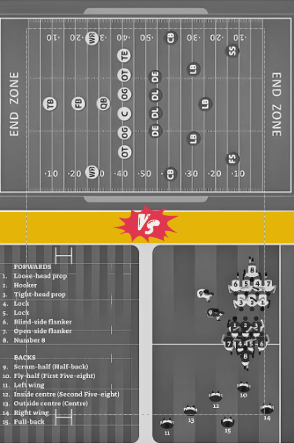
Rugby Positions:
Forwards: Large, dynamic personnel who possess the ball in the scrums and set the pace, pushing forward.
Backs: These skillful players have a knack for creating goal-scoring opportunities.
Fly-Halves: They are involved in the attack, start a charge, and kick the ball to gain space.
Fullbacks: These players defend and kick the ball with precision.
The variation of the pitch layout between American football and Rugby reveals the features of the styles, talents, and teamwork.
8. Tackling Techniques and Contact Levels
Concerning how players tackle and make contact, this has shown a big difference between American football and Rugby. Everybody has their approach and styles in tackling, and strategies are their part. This part discusses how addressing differs and impacts the safety of the game.
Since American Football is known as a high-impact physical strength collision sport, it was attractive for hits. Some of them use their shoulder or even a helmet to push the opponent away from them. This approach to the game is paramount to the sport and encourages one to gain yards and prevent the other from getting yards.
Rugby, on the other hand, is a continuous nature sport clutches tackling with style. The players try to place their arms around the active player and put them on the ground safely. It is safer and less dangerous than previous ones, which may result in extreme injuries.
The differences in player safety and the nature of the game are noticeable when looking at the takedown techniques used in American football and Rugby. These differences in tackling make these sports unique.
9. Injuries and Safety Concerns
American football and Rugby are fun and exciting games, but the safety issues are rather huge. They both have high degrees of contact that bring about accidents. It creates a tremendous concern for the protection of athletes.
Taking Care of the Risks in Both Sports
Hard hits and tackles, which can result in concussions and other severe injuries, are a common feature of American football. Because it is a continuous sport, Rugby also carries some inherent hazards, such as fractured bones and spinal cord injuries.

Both sports are implementing safety measures. They have unveiled:
- Improved safety equipment, such as modern helmets and padding
- Regulations to prevent risky behavior
- Rules for athletes who have had concussions
- Instruction on safe handling techniques
Despite these precautions, concussion injuries are nevertheless a common occurrence in these activities. Yet, efforts to reduce the effect of injuries are via research and safety enhancements. Athletes can continue to play safely in this fashion.
These statistics indicate that, while in Rugby match is more likely to cause spinal cord injury, American football has more concussions. Injuries cause American football players to miss more days on average. Every sport carries injury risks, emphasizing the importance of prioritizing player safety initiatives.
10. Cultural Significance and Fan Engagement
These two sports have evolved into cultures embraced in the United States. Both games also have the magical ability of calling fans and forming them into a community.
Deep-Rooted Tradition of American Football
Football is one of the most popular games in the United States, and numerous generations of Americans love it. Countless individuals across the nation cherished this activity, including families, friends, and community members, making it one of the most significant pastimes.
The passion for college football and the noise at NFL games all prove how influential this sport is.
Why Rugby Is Popular All Over the World and Why Fans Are So Devoted
Rugby, on the other hand, is an internationally cherished sport. This game has a smooth flow, emphasizes cooperation, and has a long existence, so everybody admires it. New Zealand, South Africa, and the United Kingdom are the hot spots of this sport.
From series like Six Nations and the Rugby World Cup, people close together because of their passion for Rugby.
Both sports have a cultural significance. It is connected to the heart of the people. The cultural influence they possess will influence future generations of players and spectators.
11. Future Trends and Evolution of Rugby vs. American Football
As American football evolves, technological breakthroughs shape its future. Smart helmets with sensors to measure player health and performance are becoming more widespread.
Furthermore, the use of data analytics improves coaching techniques and player development. The NFL prioritizes player safety, with continual attempts to prevent injuries through enhanced protective gear and adjusted training techniques.
This emphasis on safety is critical for sustaining young involvement, which has decreased owing to injury concerns.
Rugby is growing in popularity because of its inclusive character and focus on collaboration. The sport progressively incorporates technology, such as video assistant referees (VAR) and player performance statistics, to improve the game.
It is primed for considerable development as its popularity spreads, notably in the United States and Asia. Both sports are on the verge of a revolution, with innovations that promise to transform how they are played and enjoyed, assuring their continued relevance in the current athletic scene.
12. American Football vs Rugby Players
There are so many incredible athletes in American football and Rugby. They have an enormous influence on their respective games. These players stand out for their distinct qualities and contributions.
Players of American Football
Tom Brady (Quarterback )
Brady, who has won numerous Super Bowl titles, is regarded as the best quarterback in NFL history because of his outstanding leadership, precision passing, football IQ, and decision-making abilities.
Jerry Rice (Wide Receiver)
Rice is a notable figure in American Football history. His talent and skills made him great. He owns many receiving records.
Taylor Lawrence (Linebacker)
The legendary Taylor Lawrence was a two-time Super Bowl winner and a game-changing defensive standout whose speed and ferocity transformed the linebacker position.
Walter Payton (Running back)
An iconic NFL speedy runner and superb receiver known for his tenacity and flexibility, Payton also went by the moniker Sweetness for his elegant style of play.
Sanders Deion (Cornerback)
The legendary athlete Sanders was a superb wide receiver and cornerback in the NFL for his charm and quickness. He had a significant impact on defense and special teams. 1`2-oi8ufd0
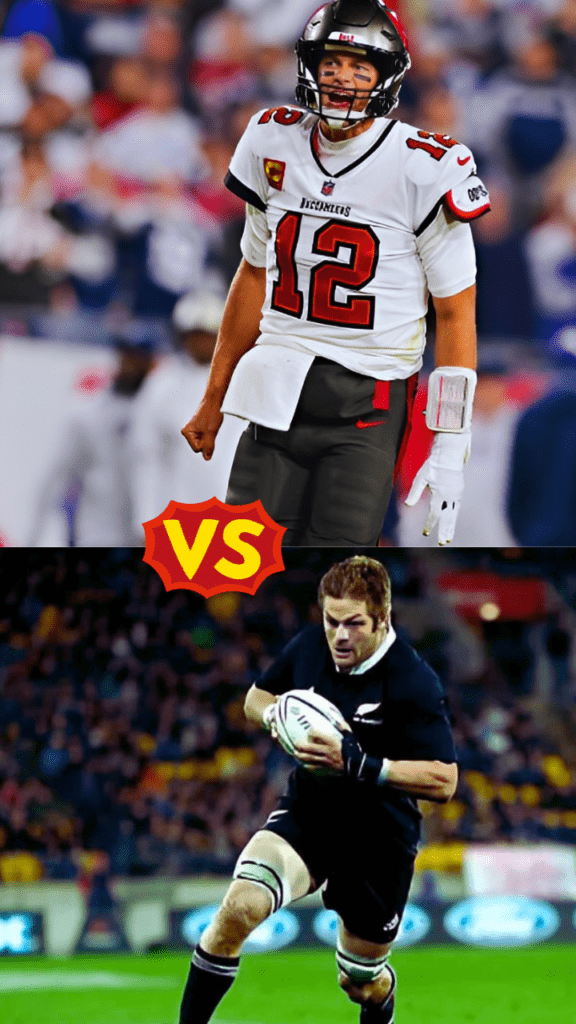
Rugby Players
Richie McCaw (Flanker)
McCaw, a two-time Rugby World Cup champion captain for New Zealand, is praised for his tactical sense and leadership qualities, which he believes best represent New Zealand Rugby.
Jonah Lomu (Wing)
Another New Zealand global sensation, Jonah Lomu, is known for stature and speed. His fast running style and techniques to break tackles are soothing for people to see wing play.
Martin Johnson (Lock)
English Rugby player Johnson, famous for his strong physical presence and leader who led England to their first Rugby World Cup triumph in 2003, was renowned for his toughness and strategic thinking.
Brian O’Driscoll (Centre)
Irish legendary Rugby player O’Driscoll, who holds the record for most tries in the Six Nations Championship, is one of Rugby’s all-time greats, known for his deft play and vision.
Beauden Barrett (Fly-Half)
Barrett is a contemporary Rugby sensation who has won several World Rugby Player of the Year honors. He is renowned for his quickness, agility, and ability to create plays. As a fly-half and fullback, he performed admirably, proving his impact on the international Rugby scene with his exceptional speed, agility, and tactical intelligence on the field.
Last Words
American football and rugby are fundamentally different sports. Their unique rules define each game’s character. American football is a strategic series of planned plays. Rugby is a continuous test of endurance and flow.
Protective gear also creates a major contrast. American football requires extensive padding and helmets. Rugby players use minimal protective equipment. This impacts tackling techniques and overall physicality. Different gear leads to different injury risks.
The key distinction lies in advancing the ball. American football allows one forward pass per down. Rugby forbids any forward passes entirely. Every pass in rugby is a backward or lateral throwball. This rule fundamentally changes each sport’s rhythm.
So, which sport is truly tougher? That is the wrong question. American football demands explosive power and precision. Rugby requires relentless stamina and adaptability. Both sports test human limits in their own ways.
Your preference depends on what you value more. Do you prefer strategic set pieces or non-stop action? Choose American football for its complex chess match. Choose rugby for its grueling marathon. Both sports offer incredible displays of strength and skill.
For more, Follow Sports Dribble on Facebook, Instagram, and Twitter.

My name is Krishanu Das the founder of the Sports Dribble.
I am Accountant by profession but a Sports Blogger by passion.
I am passionate about sharing my all knowledge and experiences of sports, with my readers and every sports enthusiast.
